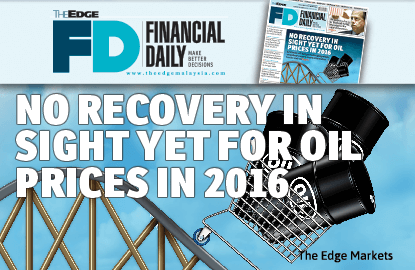
This article first appeared in The Edge Financial Daily, on December 10, 2015.

KUALA LUMPUR: The benchmark Brent and West Texas Intermediate (WTI) crude oil prices fell below US$40 (RM170.40) per barrel this week for the first time since early 2009, and though prices have since rallied — Brent was trading around US$40.66, while the WTI was just over US$38 at the time of writing — such low levels will likely prevail in the next 12 months as the oil glut persists, according to industry experts.
The fact that members of the Organization of the Petroleum Exporting Countries (Opec) failed to agree on output targets last Friday, which saw the oil price rout continuing this week, have further weighed on less-than-rosy sentiment over the commodity.
It may take years before oil prices can recover to their heyday of US$115 per barrel that was seen in mid-June 2014, said JF Apex Securities senior analyst Lee Cherng Wee, after taking the current oversupply situation and the slowdown in global economic growth into account.
“No one can tell the future, but I think we need global economic growth to step up in order to increase demand for oil,” he told The Edge Financial Daily.
Going by numbers from the International Monetary Fund — which expects the world economy to grow around 3.6% in 2016, from a forecast growth of 3.1% for 2015 — and the World Bank — which expects 3.3% gross domestic product growth in 2016, compared with its forecast of 2.8% for 2015 — growth may yet pick up.
But Kenanga Research analyst Lim Sin Kiat, too, opined that low oil prices are expected to continue until at least the second half of 2016 (2H16).
“Barring any unforeseen circumstances such as war, I believe low oil prices are here to stay for a while as it is still in oversupply. We expect this to at least continue into 2H16,” he said.
Oil and gas (O&G) service provider Dialog Group Bhd said the low oil price scenario will likely continue for the next two to three years.
“The current weak [oil] price situation will continue due to shale oil production in the US, weaker demand growth brought about by the slowdown in China’s economy, the unwillingness of Opec to act as a swing producer in order to keep their market share, and an oversupply in the market,” said the group.
UOB Kay Hian analyst Kong Ho Meng, meanwhile, opined that 2016 will be a testing year for the sector with volatility in oil prices.
“Channel checks suggest that Petroliam Nasional Bhd (Petronas) has to continuously readjust capital priorities and may further defer upstream activities. Service players with high dependence on Petronas jobs like Barakah Offshore Petroleum Bhd, Malaysia Marine and Heavy Engineering Holdings Bhd, Perisai Petroleum Teknologi Bhd, Dayang Enterprise Holdings Bhd and UMW Oil & Gas Corp Bhd will be affected,” he wrote in a Nov 12 note.
Kenanga’s Lim added that the overall outlook for the O&G industry — particularly the upstream sector — remains weak.
“However, I do expect a slight pickup in activity towards the end of 2016, due to the possibility of improvement in supply and demand dynamics for crude oil. On the other hand, downstream players such as refiners are expected to fare better due to low feedstock costs.
“Downstream-focused players like KNM Group Bhd and Petronas Chemicals Group Bhd may see better business profitability due to low oil prices, [but it may be challenging] for upstream-service players like the offshore support vessel and rig players, due to their strong correlation with oil prices should [the] prices continue to stay low,” said Lim.
From an investor’s perspective, MIDF Research analyst Aaron Tan said sentiment remains somewhat subdued.
“Investors are largely cautious about the O&G sector as global crude oil prices are still depressed and chances of a rebound seem to be capped,” said Tan.
On the outlook for O&G special-purpose acquisition companies (SPACs) in 2016, Lim said it will be an opportune time for them to acquire assets as prices are lower than before.
“However, it still boils down to the management’s ability to identify undervalued target assets and [practise] prudent cash flow management to ride out the volatile times in the industry. It is more of a long-term play for SPACs now, as most of the oilfield assets are not very profitable at the current oil prices,” he said.
For SPAC Sona Petroleum Bhd, its managing director Datuk Seri Hadian Hashim said the group counts itself lucky that it had scrapped its earlier plan to acquire Salamander Energy (Bualang Holdings) Ltd as its qualifying acquisition.
“The fact that it didn’t go through allowed us to find alternatives at a lower price for similar reserves, as assets are at cheaper prices compared with a year ago, due to lower oil prices and the outlook going forward. A lot more companies are looking for alternative means to raise capital to support their programmes — i.e. farm-out of assets.
“For Sona, at a time like this, we would want to use proceeds to focus on development spending with minimal exploration spending, as we can now buy cheaper reserves rather than exploring for reserves,” he added.